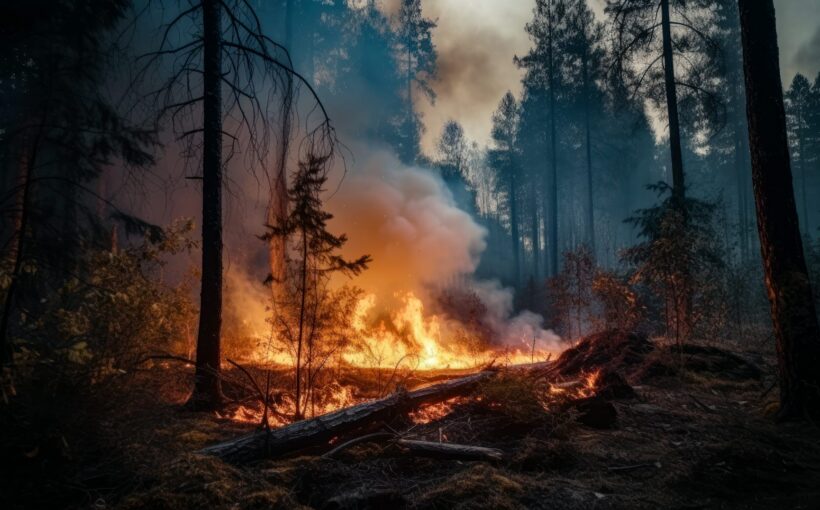
Is it possible to heat the planet to dangerous levels and then cool it down later? Economic models charting the world’s path to net zero emissions say yes.
Theoretically, the cheapest way to global decarbonisation is to delay cutting emissions to reach net zero and assume it will be possible to remove huge volumes of CO₂ from the atmosphere later. As the annual UN climate conference kicks off in Azerbaijan, hopes of sticking to the 1.5°C target, while continuing to expand fossil fuel production, are based on this assumption.
However, this bet on future large-scale carbon removal risks becoming a “get out of jail free” clause that allows high emissions to continue inflaming the climate crisis.
A new study by leading scientists has criticised the overconfidence of policymakers and climate modellers – even the authors of the 2015 Paris agreement – for making this gamble. Their research highlights the pitfalls of assuming temperature thresholds can be safely exceeded and then reinstated.
They’re right – and the problem runs even deeper. The challenge of implementing carbon removal at the scale required isn’t simply a matter of the technology being available and cost effective to deploy. Large-scale CO₂ removal depends on there being vast amounts of land to store carbon in trees and soil.
Credible and sustainable limits
The sheer space needed for schemes like tree planting and bioenergy with carbon capture and storage (burning biomass, capturing the carbon and storing it underground) would demand a transformation of how we use and manage land that may be almost impossible to deliver. And if it were actually deployed, it would further traverse other planetary boundaries, with potentially irreversible consequences.
If scientific modelling of the path to net zero emissions fails to account for these obstacles, policymakers could receive flawed advice.
In articles we published recently in the academic journals Nature Communications, Science and One Earth, we proposed how to reframe the role of carbon removal in reaching net zero emissions. A more sober assessment of carbon removal’s real-world potential will help realise its contribution to keeping global temperatures down, and refocus attention on the primary task of cutting emissions: phasing out fossil fuels.
Changing how people use land looks feasible on paper, but it often falls apart in the real world because of a complex web of social, cultural, environmental and political factors unique to each region.
Think about British sheep farmers. Their operations might not be highly profitable or climate friendly, but farming is their identity and heritage. Cold rationality says we should turn that land into forests, but culture and politics say that’s impossible.
In Brazil, soybean farmers often accrue significant debt and enter exclusive contracts with multinational seed producers, legally binding them to certain farming practices. Their use of land isn’t just a job, it’s often a trap of inescapable legal and financial commitments.

Setting aside vast territory to whisk away carbon would force major trade-offs and leave governments relying on the fantasy of perfectly balanced trade to feed their populations. In reality, governments will always put a plentiful food supply first. India’s 2023 ban on rice exports after a poor harvest shows how food security influences government decisions.
Changing how people use land to produce food, timber and fibre for clothes at the scale needed to lower temperatures means working with tens of millions of small family farms. Or it implies horrific human rights abuses if their consent is overridden.
These hurdles are systemic challenges to land-based carbon removal – and hence, of scenarios that assume overshooting and then returning below 1.5ºC of global warming.
Don’t forget ecology
Take California, where the state government experimented with rolling out a forest-based carbon removal project. This was found to be among the cheapest forms of land-based removal in the most recent IPCC report. The project included an additional risk pool of extra trees to mitigate against fire consuming the carbon the forest had removed.
The pool was intended to last a century, but burned down after ten years. The implication? Carbon removal in California will need to gobble up even more land than planned.
These examples tell us that we haven’t accepted the reality of mitigating climate change using land. Compare this with renewable energy. Researchers have a sophisticated understanding of challenges like the intermittency of energy generation from solar panels and wind turbines that can engender solutions like battery storage. As a result, clearer routes exist for scaling up renewables than for sustainable carbon removal.
A plan for global carbon removal will need to take social and political systems seriously. It also needs to factor in ecological limits – what evidence suggests ecosystems can tolerate without collapsing. This implies we should prioritise (at sustainable scales) carbon removal that also boosts biodiversity, such as restoring degraded forests, which sequester much more carbon than single-species plantations and are more resilient to increasing climate hazards like fires.
Durable, nature-positive schemes will require engaging and consulting with local communities, rather than top-down identikit solutions. This takes time.
Changing the way people use millions of hectares of land can’t be done on a spreadsheet. It requires policymakers to engage with the rich and messy reality of the way humans live on it. The patchwork of failed carbon removal schemes around the world suggests that doing this is much harder than is currently understood.
Both science and politics need to take account of this, and fast.
![]()
Ol Perkins receives funding from the Leverhulme Trust. They are a member of the UK Labour party.
Alexandra Deprez receives funding from the European Climate Foundation and from the French government’s National Research Agency (ANR) in the framework of the France 2030 Investment Plan under the reference ANR-16-IDEX-001. She is affiliated with IDDRI-Sciences Po.
Kate Dooley receives funding from the Australian Research Council.



